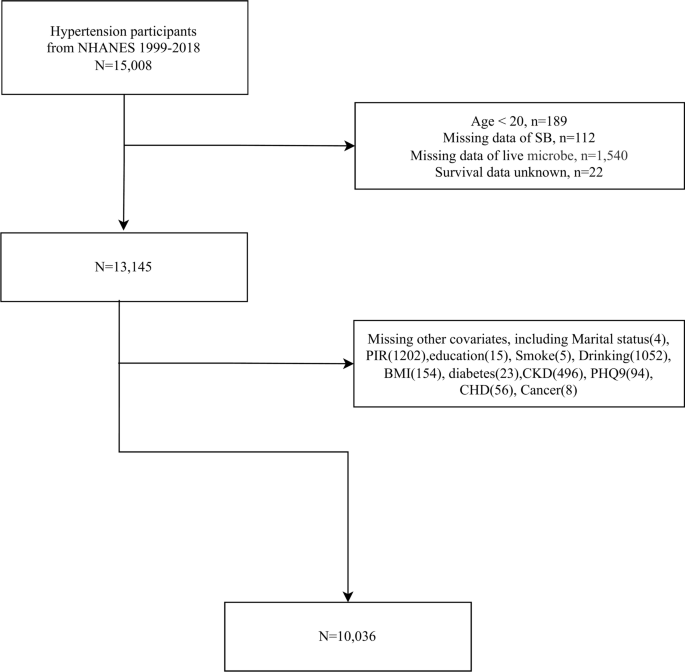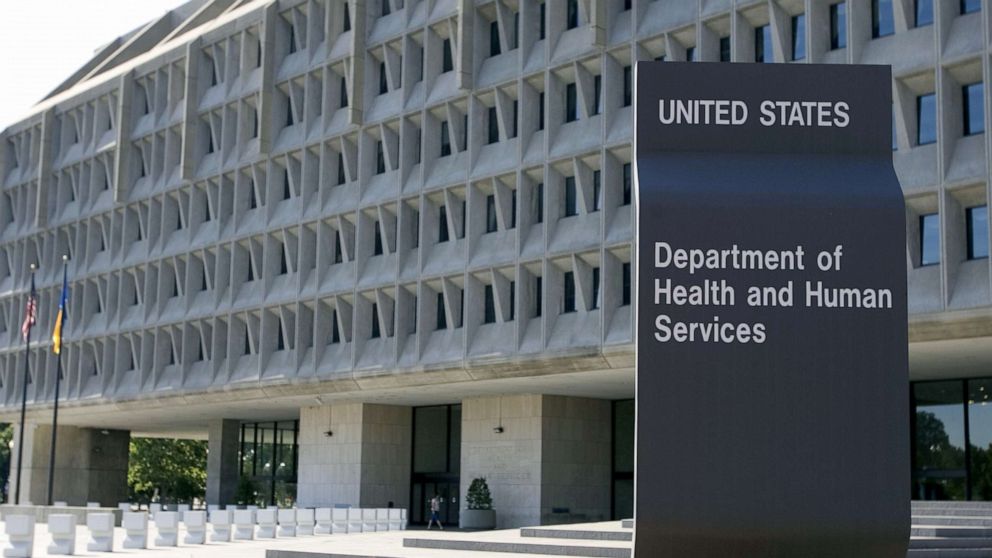Dietary intake of live microbes mitigates the mortality risk associated with sedentary behavior in US hypertensive individuals

Zhou, B., Perel, P., Mensah, G. A. & Ezzati, M. Global epidemiology, health burden and effective interventions for elevated blood pressure and hypertension. Nat. Rev. Cardiol. 18, 785–802. (2021).
Google Scholar
World Health Organization. Global Report on Hypertension: The Race Against a Silent Killer (World Health Organization, 2023).
Bailey, D. P. Sedentary behaviour in the workplace: Prevalence, health implications and interventions. Br. Med. Bull. 137, 42–50. (2021).
Google Scholar
Babey, S. H., Hastert, T. A. & Wolstein, J. Adolescent sedentary behaviors: Correlates differ for television viewing and computer use. J. Adolesc. Health. 52, 70–76. (2013).
Google Scholar
Hermelink, R. et al. Sedentary behavior and cancer—an umbrella review and meta-analysis. Eur. J. Epidemiol. 37, 447–460. (2022).
Google Scholar
Li, X., Ma, H., Zhou, T. & Qi, L. Replacing sedentary behavior time with physical activities, recommended physical activity, and incident coronary heart disease. Mayo Clin. Proc. 98, 111–121. (2023).
Google Scholar
van Deel, E. D., Octavia, Y., de Waard, M. C., de Boer, M. & Duncker, D. J. Exercise training has contrasting effects in myocardial infarction and pressure overload due to divergent endothelial nitric oxide synthase regulation. Int. J. Mol. Sci. 19, 1968. (2018).
Google Scholar
Hasegawa, N. et al. Effects of different exercise modes on arterial stiffness and nitric oxide synthesis. Med. Sci. Sports Exerc. 50, 1177–1185. (2018).
Google Scholar
Engin, B. et al. Sedentary time is independently related to adipose tissue insulin resistance in adults with or at risk of type 2 diabetes. Med. Sci. Sports Exerc. 55, 1548–1554. (2023).
Google Scholar
La Favor, J. D. et al. Microvascular endothelial dysfunction in sedentary, obese humans is mediated by NADPH oxidase: Influence of exercise training. Arterioscler. Thromb. Vasc. Biol. 36, 2412–2420. (2016).
Google Scholar
Tjurin, P. et al. Cross-sectional associations of sedentary behavior and sitting with serum lipid biomarkers in midlife. Med. Sci. Sports Exerc. 54, 1261–1270. (2022).
Google Scholar
Subramanian, M. & Mueller, P. J. Altered differential control of sympathetic outflow following sedentary conditions: Role of subregional neuroplasticity in the RVLM. Front. Physiol. 7, 290. (2016).
Google Scholar
Mueller, P. J. Influence of sedentary versus physically active conditions on regulation of plasma renin activity and vasopressin. Am. J. Physiol. Regul. Integr. Comp. Physiol. 295, R727–R732. (2008).
Google Scholar
Abenavoli, L. et al. Gut microbiota and obesity: A role for probiotics. Nutrients 11, 2690. (2019).
Google Scholar
Culp, E. J., Nelson, N. T., Verdegaal, A. A. & Goodman, A. L. Microbial transformation of dietary xenobiotics shapes gut microbiome composition. Cell 187, 6327-6345.e20. (2024).
Google Scholar
Liu, M. et al. Lipid-lowering, antihypertensive, and antithrombotic effects of nattokinase combined with red yeast rice in patients with stable coronary artery disease: A randomized, double-blinded, placebo-controlled trial. Front. Nutr. 11, 1380727. (2024).
Google Scholar
Shah, A. B. et al. Probiotic significance of Lactobacillus strains: A comprehensive review on health impacts, research gaps, and future prospects. Gut. Microbes. 16, 2431643. (2024).
Google Scholar
O’Donnell, J. A., Zheng, T., Meric, G. & Marques, F. Z. The gut microbiome and hypertension. Nat. Rev. Nephrol. 19, 153–167. (2023).
Google Scholar
Kyoung, J. & Yang, T. Depletion of the gut microbiota enhances the blood pressure-lowering effect of captopril: Implication of the gut microbiota in resistant hypertension. Hypertens Res. 45, 1505–1510. (2022).
Google Scholar
Kong, C. Y. et al. Probiotic yogurt blunts the increase of blood pressure in spontaneously hypertensive rats via remodeling of the gut microbiota. Food Funct. 12, 9773–9783. (2021).
Google Scholar
Gómez-Contreras, A. et al. Dietary intake of table olives exerts antihypertensive effects in association with changes in gut microbiota in spontaneously hypertensive rats. Food Funct. 14, 2793–2806. (2023).
Google Scholar
Młynarska, E. et al. Gut microbiota and gut-brain axis in hypertension: Implications for kidney and cardiovascular health-a narrative review. Nutrients 16, 4079. (2024).
Google Scholar
Qu, S. et al. Gut microbiota modulates neurotransmitter and gut-brain signaling. Microbiol. Res. 287, 127858. (2024).
Google Scholar
Lai, H. et al. Effects of dietary fibers or probiotics on functional constipation symptoms and roles of gut microbiota: A double-blinded randomized placebo trial. Gut. Microbes. 15, 2197837. (2023).
Google Scholar
Shen, F. et al. Ligilactobacillus acidipiscis YJ5 modulates the gut microbiota and produces beneficial metabolites to relieve constipation by enhancing the mucosal barrier. Food Funct. 15, 310–325. (2024).
Google Scholar
Zhu, W. et al. Priestia megaterium ASC-1 Isolated from pickled cabbage ameliorates hyperuricemia by degrading uric acid in rats. Microorganisms. 12, 832. (2024).
Google Scholar
Song, X. et al. The gut microbiota-brain axis: Role of the gut microbial metabolites of dietary food in obesity. Food Res. Int. 153, 110971. (2022).
Google Scholar
Kim, D. W. et al. Effects of kimchi intake on the gut microbiota and metabolite profiles of high-fat-induced obese rats. Nutrients 16, 3095. (2024).
Google Scholar
Amato, K. R. et al. Variable responses of human and non-human primate gut microbiomes to a Western diet. Microbiome. 3, 53. (2015).
Google Scholar
Gu, S. et al. The relationship between dietary intake of live microbes and insulin resistance among healthy adults in the US: A cross-sectional study from NHANES 2003–2020. Sci Rep. 14, 17666. (2024).
Google Scholar
Huo, X. et al. Association of dietary live microbe intake with frailty in US adults: Evidence from NHANES. J. Nutr. Health Aging. 28, 100171. (2024).
Google Scholar
Yan, K. et al. Higher dietary live microbe intake is associated with a lower risk of sarcopenia. Clin. Nutr. 43, 1675–1682. (2024).
Google Scholar
Chang, Q. et al. Replacement of sedentary behavior with various physical activities and the risk of all-cause and cause-specific mortality. BMC Med. 22, 385. (2024).
Google Scholar
Sun, Y. et al. Replacement of leisure-time sedentary behavior with various physical activities and the risk of dementia incidence and mortality: A prospective cohort study. J. Sport Health Sci. 12, 287–294. (2023).
Google Scholar
Xu, G., Ma, E., Zhang, W. & Feng, B. Association between healthy eating index-2015 total and metabolic associated fatty liver disease in Americans: A cross-sectional study with US. National health and nutrition examination survey. Front. Nutr. 11, 1427619. (2025).
Google Scholar
Vukic, V. R. et al. In silico identification of milk antihypertensive di- and tripeptides involved in angiotensin I-converting enzyme inhibitory activity. Nutr. Res. 46, 22–30. (2017).
Google Scholar
Yamamoto, N., Maeno, M. & Takano, T. Purification and characterization of an antihypertensive peptide from a yogurt-like product fermented by Lactobacillus helveticus CPN4. J. Dairy Sci. 82, 1388–1393. (1999).
Google Scholar
Xiong, R. G. et al. Health benefits and side effects of short-chain fatty acids. Foods. 11, 2863. (2022).
Google Scholar
Robles-Vera, I. et al. Protective effects of short-chain fatty acids on endothelial dysfunction induced by angiotensin II. Front. Physiol. 11, 277. (2020).
Google Scholar
Robles-Vera, I., Toral, M. & Duarte, J. Microbiota and hypertension: Role of the sympathetic nervous system and the immune system. Am. J. Hypertens. 33, 890–901. (2020).
Google Scholar
Bartolomaeus, H. et al. Short-chain fatty acid propionate protects from hypertensive cardiovascular damage. Circulation 139, 1407–1421. (2019).
Google Scholar
Richards, E. M., Li, J., Stevens, B. R., Pepine, C. J. & Raizada, M. K. Gut microbiome and neuroinflammation in hypertension. Circ. Res. 130, 401–417. (2022).
Google Scholar
Cheng, S. et al. The probiotic fermented milk of Lacticaseibacillus paracasei JY062 and Lactobacillus gasseri JM1 alleviates constipation via improving gastrointestinal motility and gut microbiota. J. Dairy Sci. 107, 1857–1876. (2024).
Google Scholar
Rothman, A. M. et al. Effects of interleukin-1β Inhibition on blood pressure, incident hypertension, and residual inflammatory risk: A secondary analysis of CANTOS. Hypertension 75, 477–482. (2020).
Google Scholar
Aya, V., Flórez, A., Perez, L. & Ramírez, J. D. Association between physical activity and changes in intestinal microbiota composition: A systematic review. PLoS ONE 16, e0247039. (2021).
Google Scholar
Aya, V., Jimenez, P., Muñoz, E. & Ramírez, J. D. Effects of exercise and physical activity on gut microbiota composition and function in older adults: A systematic review. BMC Geriatr. 23, 364. (2023).
Google Scholar
Pérez-Prieto, I., Plaza-Florido, A., Ubago-Guisado, E., Ortega, F. B. & Altmäe, S. Physical activity, sedentary behavior and microbiome: A systematic review and meta-analysis. J Sci Med Sport. 27, 793–804. (2024).
Google Scholar
Castellanos, N. et al. Key bacteria in the gut microbiota network for the transition between sedentary and active lifestyle. Microorganisms. 8, 785. (2020).
Google Scholar
Xia, W. J. et al. Antihypertensive effects of exercise involve reshaping of gut microbiota and improvement of gut-brain axis in spontaneously hypertensive rat. Gut. Microbes. 13, 1–24. (2021).
Google Scholar
Carey, R. A. & Montag, D. Exploring the relationship between gut microbiota and exercise: Short-chain fatty acids and their role in metabolism. BMJ Open Sport Exerc. Med. 7, e000930. (2021).
Google Scholar
van de Wouw, M. et al. Short-chain fatty acids: Microbial metabolites that alleviate stress-induced brain-gut axis alterations. J. Physiol. 596, 4923–4944. (2018).
Google Scholar
Zhu, Q., Jiang, S. & Du, G. Effects of exercise frequency on the gut microbiota in elderly individuals. Microbiologyopen. 9, e1053. (2020).
Google Scholar
Mizoguchi, R. et al. Impact of gut microbiome on the renin-aldosterone system: Shika-machi super preventive health examination results. Hypertens. Res. 46, 2280–2292. (2023).
Google Scholar
Li X, Xia Y, Song X, Xiong Z, Ai L, Wang G. Probiotics intervention for type 2 diabetes mellitus therapy: a review from proposed mechanisms to future prospects. Crit. Rev. Food Sci. Nutr. (2024): https://doi.org/10.1080/10408398.2024.2387765.
Pinkas, M. & Brzozowski, T. The role of the myokine irisin in the protection and carcinogenesis of the gastrointestinal tract. Antioxidants 13, 413. (2024).
Google Scholar
Li, C., Cai, Y. Y. & Yan, Z. X. Brain-derived neurotrophic factor preserves intestinal mucosal barrier function and alters gut microbiota in mice. Kaohsiung J. Med. Sci. 34, 134–141. (2018).
Google Scholar
Parsons, T. J. et al. Physical activity, sedentary behavior, and inflammatory and hemostatic markers in men. Med. Sci. Sports Exerc. 49(3), 459–465. (2017).
Google Scholar
Lynch, G. M., Murphy, C. H., Castro, E. M. & Roche, H. M. Inflammation and metabolism: The role of adiposity in sarcopenic obesity. Proc. Nutr. Soc. 16, 1–13. (2020).
Google Scholar
Tian, Z., Zhuang, X., Luo, M., Yin, W. & Xiong, L. The propionic acid and butyric acid in serum but not in feces are increased in patients with diarrhea-predominant irritable bowel syndrome. BMC Gastroenterol. 20, 73. (2020).
Google Scholar
Kamath, P. S., Phillips, S. F. & Zinsmeister, A. R. Short-chain fatty acids stimulate ileal motility in humans. Gastroenterology 95, 1496–1502. (1988).
Google Scholar
Li, S. et al. Innovative beverage creation through symbiotic microbial communities inspired by traditional fermented beverages: Current status, challenges and future directions. Crit. Rev. Food Sci. Nutr. 64, 10456–10483. (2024).
Google Scholar
Pyo, Y., Kwon, K. H. & Jung, Y. J. Probiotic functions in fermented foods: Anti-viral, immunomodulatory, and anti-cancer benefits. Foods. 13, 2386. (2024).
Google Scholar
de Souza, H. F. et al. Water kefir in co-fermentation with Saccharomyces boulardii for the development of a new probiotic mead. Food Sci. Biotechnol. 33, 3299–3311. (2024).
Google Scholar
Liu, L. et al. Traditional fermented soybean products: Processing, flavor formation, nutritional and biological activities. Crit. Rev. Food Sci. Nutr. 62, 1971–1989. (2022).
Google Scholar
Cunha, S. C., Alves, R. N., Fernandes, J. O., Casal, S. & Marques, A. First approach to assess the bioaccessibility of bisphenol A in canned seafood. Food Chem. 232, 501–507. (2017).
Google Scholar
Franchi, C. et al. Inverse association between canned fish consumption and colorectal cancer risk: Analysis of two large case-control studies. Nutrients 14, 1663. (2022).
Google Scholar
Yao, H. et al. Sex differences in association of healthy eating pattern with all-cause mortality and cardiovascular mortality. BMC Public Health 24, 2363. (2024).
Google Scholar
link

:max_bytes(150000):strip_icc()/The-number-1-PM-Habit-to-Start-If-You-Have-Arthritis-96b0fdcb84614811af31480994ca945d.jpg)




